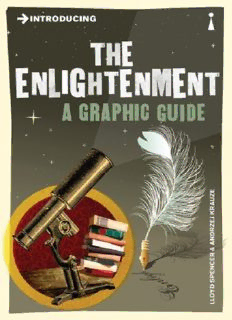
Introducing the Enlightenment: A Graphic Guide PDF
Preview Introducing the Enlightenment: A Graphic Guide
Published by Icon Books Ltd, Omnibus Business Centre, 39–41 North Road, London N7 9DP Email: [email protected] www.introducingbooks.com ISBN: 978-178578-006-6 Text copyright © 2012 Icon Books Ltd Illustrations copyright © 2012 Icon Books Ltd The author and illustrator has asserted their moral rights Originating editor: Richard Appignanesi No part of this book may be reproduced in any form, or by any means, without prior permission in writing from the publisher. Contents Cover Title Page Copyright Let There Be Light... The Radiance of the Absolute Monarchs Paris, the Capital of the Enlightenment Beginnings of the Light England’s “Glorious Revolution” An Age of Revolutions Coffee-houses, Social Clubs and Journalism Locke’s “Tabula Rasa” The Language of the Self Understanding the Limits of Our Understanding Psychology and the Novel Tristram Shandy Locke’s Social Influence Fictions in the Service of Truth The Adventures of ... Philosophers’ Novels Candide Novels of the Enlightenment The Idea of the Noble Savage The Persian Letters Voltaire Flees to England Letters on England Voltaire on Religion in England Freedom of Conscience and the Commercial Spirit On Parliament The Patron Saints of the Enlightenment The Father of Experimental Philosophy John Locke’s Politics Isaac Newton The Philosophes Enlightened Woman Enlightened Mistresses Readers and Censors Industry and Science The Encyclopédie The Tree of Knowledge Who Are the “Great Men” of History? The Importance of Crafts or Trades Metaphysics and Machinery The Pinnacle of Success The Philosophes Under Attack The Crisis of 1758 Malesherbes – or “Monsieur Guillaume” For and Against the King The Adventures of Monsieur Guillaume Denis Diderot The “Secret History” of His Soul Diderot and Friends What is an Encyclopédie? Art of the Enlightenment Jean-Jacques Rousseau (1712–78) Rousseau’s Challenge Discourse on the Origins of Inequality Voltaire vs. Rousseau Nature and Natural History Nature as a System: Linnaeus Nature as History: Buffon The Scandal of Materialism La Mettrie and Helvétius Materialism and the Improvement of Human Beings Holbach The Factory of Freethinkers D’Alembert’s Dream The Dream The French Parlements Montesquieu’s Spirit of the Laws Natural Law An Unkempt Masterpiece Individual Liberty and The Rule of Law Enlightening the Despots Frederick II of Prussia Catherine the Great of Russia Instructions to the Empress The Priest and the Philosopher Philosophers Will Never Form a Religious Sect The Catholic Church in France The Age of Enlightenment as an Age of Faith The Social Necessity of Religion Putting the Fear of Hell ... The Church, the State and Civil Rights Freemasonry The Great Watchmaker The Scepticism of David Hume A Treatise of Hum(e)an Nature Music of the Enlightenment Savage Rousseau Voyage to the Interior Rousseau’s Confessions The First Romantic Adam Smith (1723–90) A Theory of Moral Sentiments Wealth of Nations, 1776 The Invisible Hand Smith and Rousseau Samuel Johnson (1709–84) Smith Joins Dr Johnson’s Literary Club Benjamin Franklin (1706–90) The American Revolution Declaration of the Rights of Man The Poor and the Slaves Condemnation of Slavery The Defence of Slavery Immanuel Kant (1724–1804) What is Enlightenment? The Counter-Enlightenment Georg Hamann (1730–88) Language, the Organon* of Reason Sturm und Drang Voltaire at Ferney A One-Man Amnesty International The Canaille Crisis in the Old Régime The French Revolution The End of the Enlightenment The Apotheosis of Jean-Jacques The Ideal Republic The Enlightenment Project – Finished or Unfinished? Further Reading Index Let There Be Light... The Enlightenment was an intellectual current that galvanized Europe during the course of the 18th century. Centred in Paris, it spread itself across the whole of Europe to the American colonies. Networks of writers and thinkers gave the 18th century a remarkable intellectual coherence. The intellectuals of the Enlightenment felt themselves to be part of a great movement representing the highest aspirations and possibilities of mankind. They were reformers who believed their cause was best served by the new passion for argument, criticism and debate.
Description: